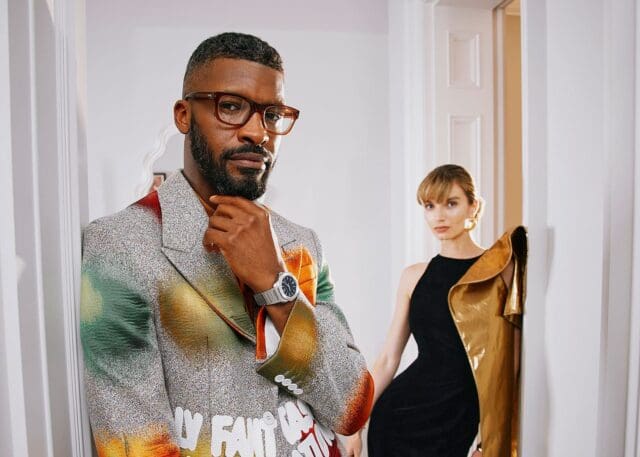
Inside Harrods’ Revamped Menswear Department
The biggest refurbishment in Harrods’ 170-year history will see its menswear department, currently spread across three floors, consolidated to one. As the first of seven phases opens, head of menswear – and pioneer behind the change
You know a store has been doing something right when it can count luminaries such as Oscar Wilde, Charlie Chaplin and Laurence Olivier among its fans. For more than 120 years, Harrods has been catering to the discerning gentleman, dressing the famous, infamous and anonymous with its prized sartorial stock. The inaugural men’s department opened in 1894 with an array of dapper accessories, ranging from umbrellas to socks, and by the turn of the century it had expanded its offering to include bespoke tailoring and ready-to-wear. In a bid to rival Savile Row, a specific tailoring workshop was set up shortly after in Hans Crescent, and by 1930 the Harrods Man’s Shop had taken over the store’s ground floor.

Now, nearly 90 years later, Harrods is relocating its menswear and sports departments to the second floor in a monumental seven-phase redevelopment, that launched last year. Two years, £200m and more than 16,000 tiles and 2,060 sq m of marble have gone into the creation of the first-phase, Superbrands, a 41,000 sq ft destination space for 19 of the world’s foremost fashion brands. Here, each mini concession is a store within itself, with its own unique design and quirks – at Berluti, there’s a football table and bar for mid-shopping pick-me-ups, while Louis Vuitton has created its own private shopping suite. The second phase, and the first of the International Designer rooms, is due to open in March. Harrods’ head of menswear, Simon Longland, explains why he’s been pioneering this menswear revolution.
Menswear has had the biggest percentage growth at Harrods for two years in a row. The department has evolved over a number of decades, but it had got to the point where it was spread across several floors, and it wasn’t making for the most cohesive or enjoyable journey for the Harrods man. We decided our customers needed to be treated better, and given a single destination appropriate to them.
The core aim is to provide men with the ultimate shopping destination. The first phase opened in November last year, and we will be opening a number of other phases between now and 2020. Each section will focus on a different department or product category and there will also be two restaurants, a bar, barber, tailor and pop-up shops. There should be no reason to leave the floor once you get there.
We’re working with David Collins Studio for the entire floor, so there is going to be one architectural vision for all 155,000 sq ft. It was important to us that there was a sense of coherence and flow, and, above all, that Harrods Man has an identity of its own. Before the design team started the project, they spent time going through our archives. They have a real understanding and respect for the history and heritage of the Harrods building, and the phase that is already open has an Art Deco flavour to it – but it isn’t in any way pastiche. It feels very modern, but at the same time has historical nods to the building’s design. If you’d never been to Harrods before, you would be hard pushed to know when the department had been built.

There’s going to be a huge array of brands across the floor. In our Superbrands section, we have a mix of more fashion and sartorial-focused brands, so at one end there is Balenciaga, Gucci, Louis Vuitton and Dior, and at the other there are labels such as Berluti and Ermenegildo Zegna. The second phase is the first of the International Designer rooms. Here, the brands have been curated based on their timelessness and seasonality. They’re very beautiful, but they’re not about chasing the trends; think Brunello Cucinelli, Salvatore Ferragamo, Giorgio Armani, Etro and Missoni.

We wanted to create an environment that is engaging and somewhere our customers would want to spend time. We’re building pop-up spaces within every phase of the floor, so if a brand has a collaboration or a capsule collection, we can really celebrate that in a significant way. The pop-up spaces are also there to showcase things that aren’t menswear, with products that we think the customer will find interesting or engaging, such as a new watch, fragrance, headphones or a candle.
Men are definitely becoming more product-obsessed. For a long time in womenswear, people would come in because they need ‘the’ bag, or a new must-have accessory. We now have guys coming in who’ve seen a T-shirt or a pair of sneakers – anything they’ve seen on Instagram – and they need it. It shows that men do enjoy and want to shop. It isn’t a chore.

Men’s shopping habits depend quite a lot on the man. For our younger customers – or the millennial customer in general – there is very little difference between men and women, but our older customer is more of a destination shopper. He’s more brand loyal, knows what he wants and is coming to fulfil a need. But it varies wildly; the historical association that men don’t like to shop is becoming less and less true with every passing year.









